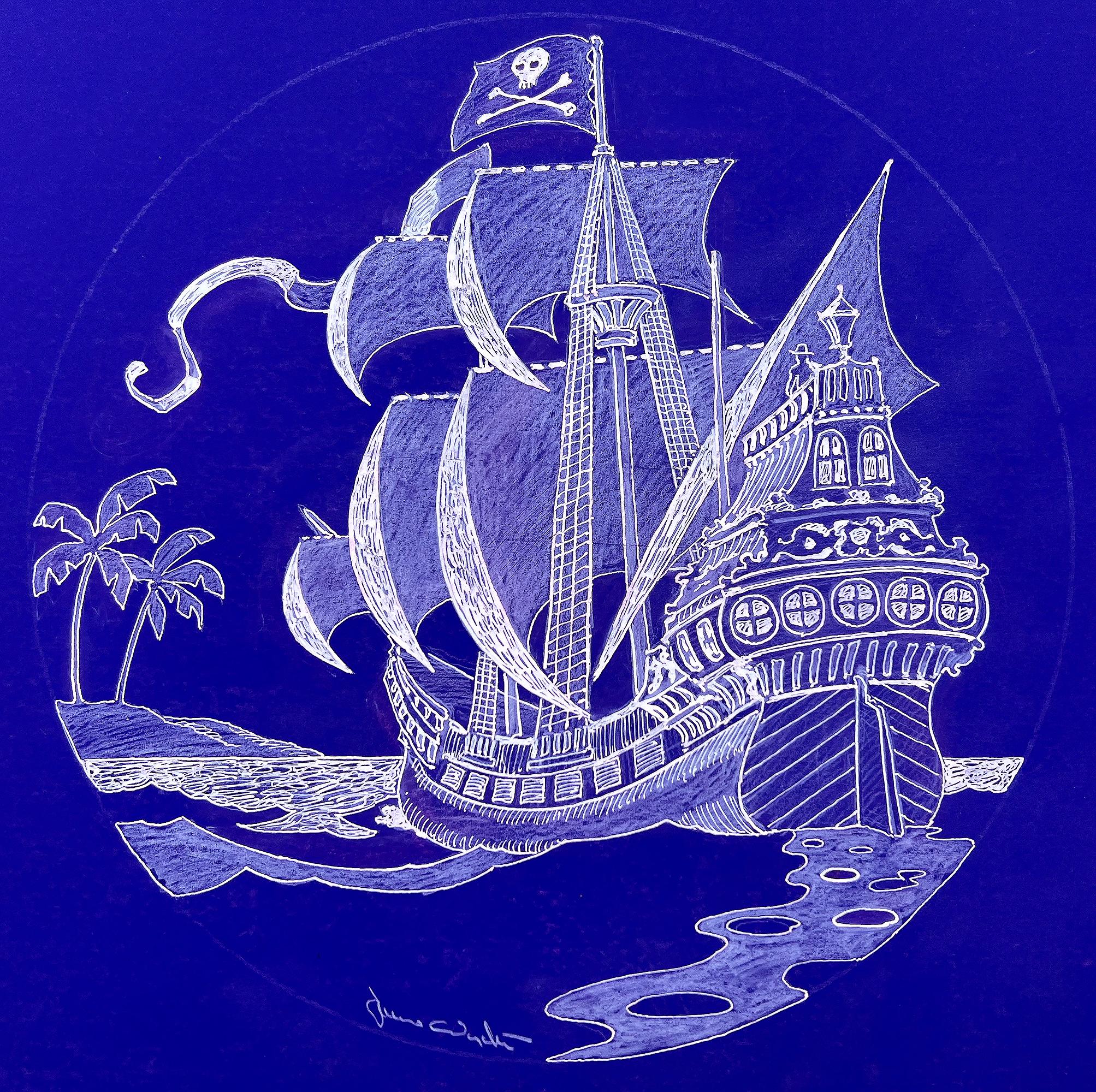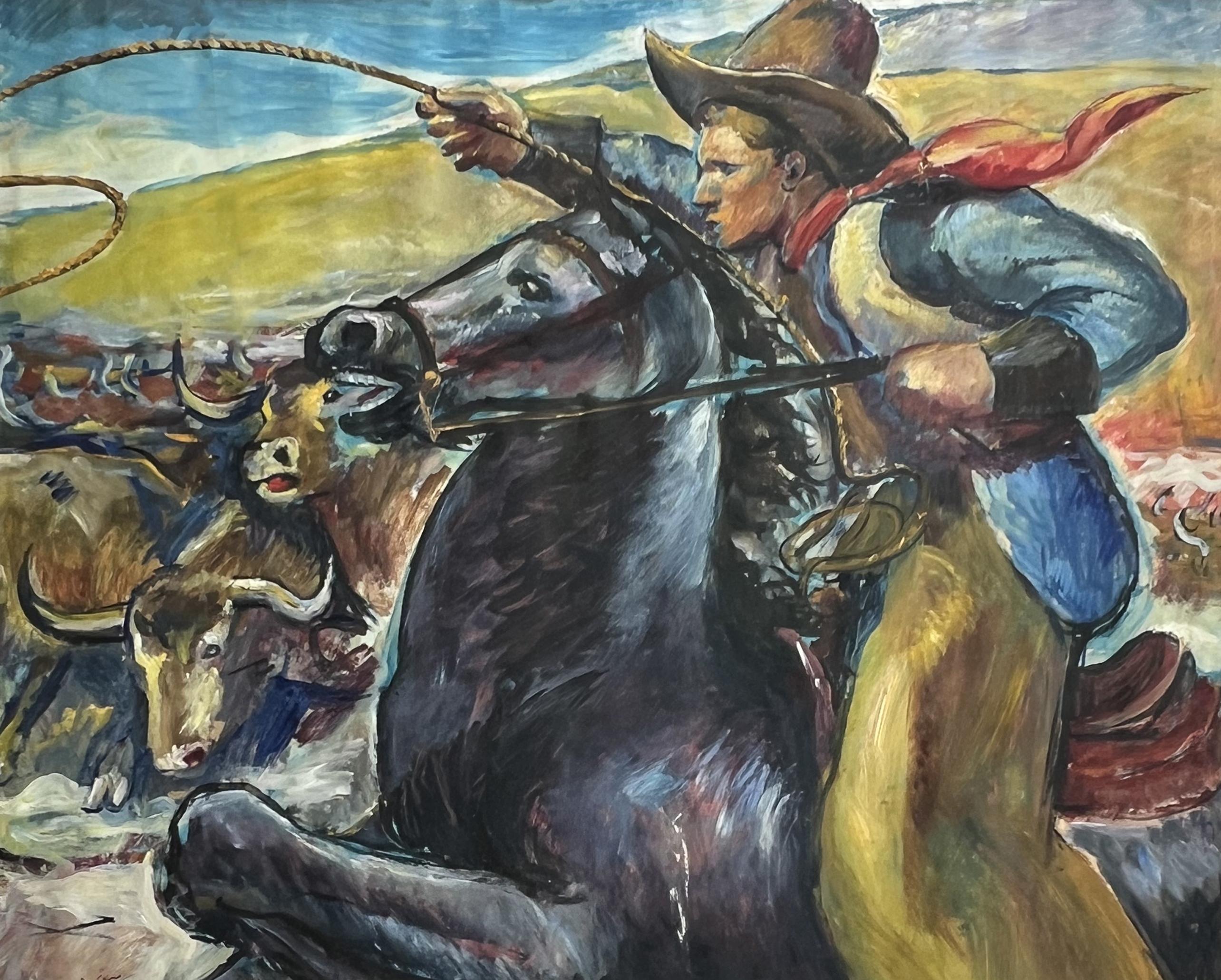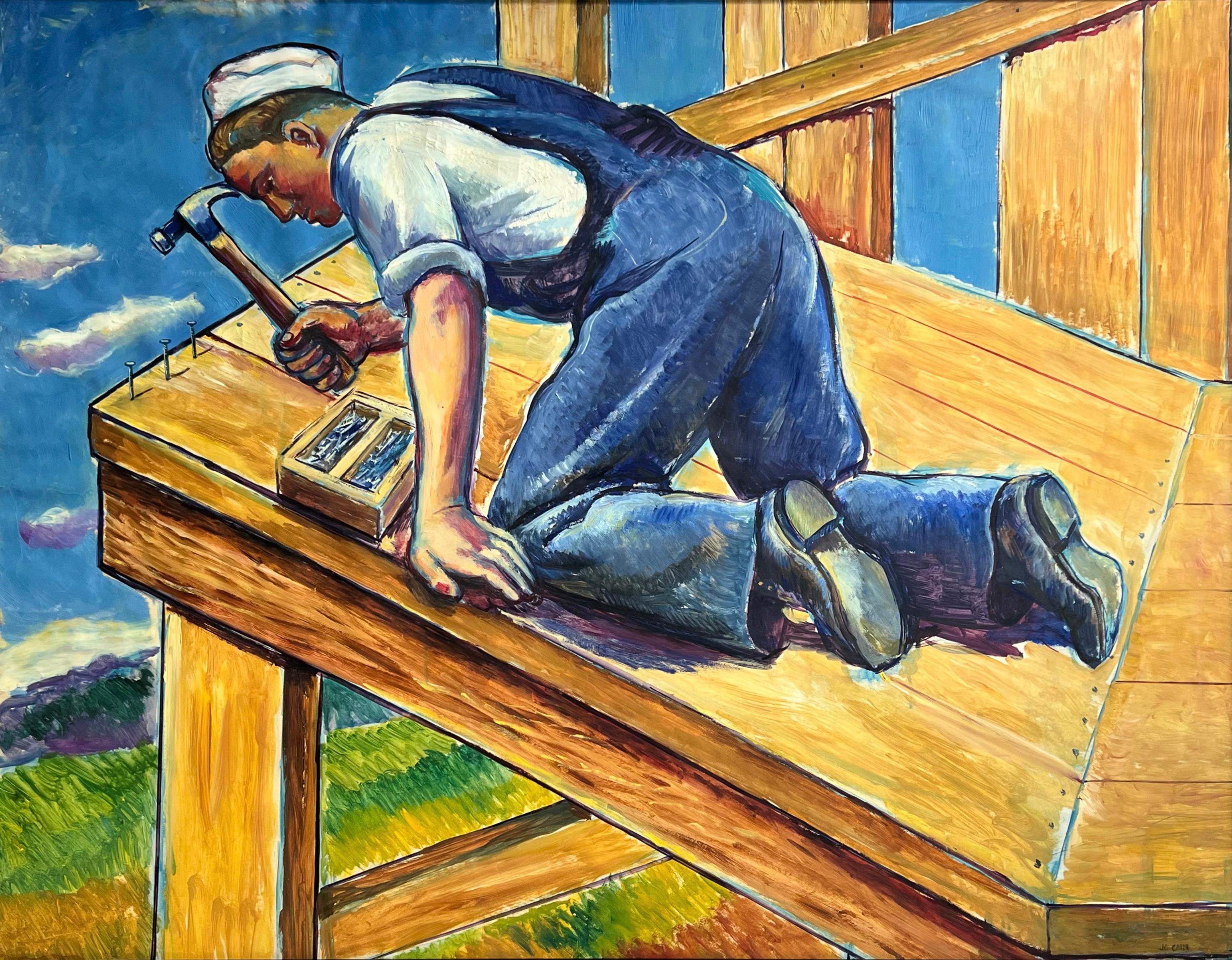Items Similar to Greenwich Village NYC WPA Mid 20th Century American Scene Ashcan Modern Realism
Want more images or videos?
Request additional images or videos from the seller
1 of 8
alfred miraGreenwich Village NYC WPA Mid 20th Century American Scene Ashcan Modern Realismc. 1930s
c. 1930s
About the Item
Greenwich Village NYC WPA Mid 20th Century American Scene Ashcan Modern Realism
Alfred Mira (1900-1981)
Greenwich Village NYC
14 x 17 inches
Oil on board, c. 1930s
Signed lower right
26 1/2 x 30 framed
We are not certain of the exact location depicted in the painting. It could be where Greenwich meets West 13th Street or 11th Street. The site could also be Seventh, Greenwich and West 11th, across from where St Vincent’s used to be. The tower in the right hand corner looks like the top of the (now) Jefferson Square Library. Those spots claim to be the diner in Hopper’s “Nighthawks."
BIO - in the artist's words
My boyhood days were spent between school and my father's carpentry shop. My interest in both these fields was overshadowed by my insatiable desire to draw. The books from which I was to learn my reading, writing and arithmetic were cluttered with pictures I had drawn on every available blank space. This aroused the wrath of my teachers who showed their unfriendliness. I believe I was allowed to graduate, not because I was an astute student, but because of their desire to be rid of me.
I embarked on my studies by obtaining a Job at an interior decorator's studio. My wish, however, was to go to an art school but this was impossible because my parents felt that a fifty-cent daily expenditure was an extravagance for a hobby in which they there was no future. My Salary at the studio was $3.00 a week, which my father granted me the right to save.
In 1919 I entered the National Academy of Design. My saving soon dwindled, so I left school and went back to work. I found employment in a Mural Art Studio. When time permitted, I attended the studio class at Beaux Arts School. After three years, I again matriculated at the National Academy in Ivan Olinsky's class.
At every opportunity I went outdoors to paint. My friends suggested that I have a studio exhibition with these studies and to my surprise, I sold almost all, so I planned to go to California where the climate and color were most suitable for my purpose. I was joined by a fellow student in this trip, who suggested we hitchhike our way to the coast so that we could stop here and there to paint. So we started our journey. We took the ferry to New Jersey and from there on we exercised our thumbs. One of our "lifters" suggested that we go via Detroit and stop there to paint the portraits of his parents. This was my first commission, and I need not say that I was filled with anxiety and fear. The results of this work brought several other portraits. After a few months, I became so absorbed in my work that I had completely forgotten about California. By this time my companion had become homesick and he induced me to return with him.
In 1926, with the money I had earned, I was able to have a good skylight studio, and there I set on a career of earning a living with painting, at the same time attending the studio class at the Art Students League.
The lure of the outdoors always attracted me, especially the city streets with their movements, color and depth-they were the things that inspired me and which I painted as they looked and as I felt them. Judging by my style and subjects, my artist friends argued that I was influenced by French Impressionists. While I bare great esteem for the French Masters, I do not claim comparison with them. However, my ultimate goal is to paint exclusively American Impressionism.
In 1928, my adventurous spirit took hold of me again and I went to Europe. I arrived in Paris and found that the gay life was not conducive to constructive work, so I went to South France with its sunny skies and mild climate where I was able to accomplish more. After traveling throughout the continent, I was awakened to the realization that the work I had done in Europe did not serve my purposes, and that I was better inspired in Washington Square.
Back home in New York, I devoted myself to painting street scenes. In 1929, my first effort to exhibit one of my street scenes was at the National Academy. The critics received this very kindly and I was so encouraged that I attempted other national exhibits that have flattered me in accepting every one of my paintings.
- Creator:alfred mira (1900 - 1981, American)
- Creation Year:c. 1930s
- Dimensions:Height: 26.5 in (67.31 cm)Width: 30 in (76.2 cm)
- Medium:
- Movement & Style:
- Period:
- Condition:
- Gallery Location:New York, NY
- Reference Number:1stDibs: LU1156212698582
About the Seller
5.0
Gold Seller
These expertly vetted sellers are highly rated and consistently exceed customer expectations.
Established in 2008
1stDibs seller since 2019
165 sales on 1stDibs
Typical response time: <1 hour
- ShippingRetrieving quote...Ships From: Pawling, NY
- Return PolicyA return for this item may be initiated within 3 days of delivery.
More From This SellerView All
- "Good Health Week" WPA American Scene Mid 20th Century Modern Social RealismBy Jo CainLocated in New York, NY"Good Health Week" WPA American Scene Mid 20th Century Modern Social Realism Jo Cain (1904 – 2003) Good Health Week 10 ½ x 15 1/2 inches Oil on pape...Category
1940s American Realist Figurative Drawings and Watercolors
MaterialsPaper, Oil
- Cowboys Horses Cattle WPA American Scene Social Realism Mid 20th Century ModernBy Jo CainLocated in New York, NYCowboys Horses Cattle WPA American Scene Social Realism Mid 20th Century Modern Jo Cain (1904 – 2003) Cowboy 33 3/4 x 36 inches Oil on paper, c. 1930s Signed...Category
1930s American Realist Figurative Drawings and Watercolors
MaterialsPaper, Oil
- Railroad Worker Industrial WPA American Scene Mid Century Modern Social RealismBy Jo CainLocated in New York, NYRailroad Worker Industrial WPA American Scene Mid Century Modern Social Realism Jo Cain (1904 - 2003) Railroad worker 36 ¼ x 27 inches Oil on paper c. 1930s S...Category
1930s American Realist Figurative Drawings and Watercolors
MaterialsPaper, Oil
- Industrial Man Working Mid 20th Century American Scene Social Realism Modern WPABy Jo CainLocated in New York, NYIndustrial Man Working Mid 20th Century American Scene Social Realism Modern WPA Jo Cain (1904 - 2003) Hammering Nails 39 x 50 ½ inches Gouache on paper c. 19...Category
1930s American Realist Figurative Drawings and Watercolors
MaterialsPaper, Gouache
- Two Men on a Street Early 20th Century w/c Fauvism Social Realism American SceneBy Stuart DavisLocated in New York, NYTwo Men on a Street Early 20th Century w/c Fauvism Social Realism American Scene Note: We have three similar in style works from 1911 available now on 1stDibs. All are framed identi...Category
Early 1900s American Realist Figurative Drawings and Watercolors
MaterialsPaper, Watercolor
- Answering the Door Early 20th Century w/c Fauvism Social Realism American SceneBy Stuart DavisLocated in New York, NYAnswering the Door Early 20th Century w/c Fauvism Social Realism American Scene Note: We have three similar in style works from 1911 available now on 1stDibs. All are framed identi...Category
1910s American Realist Figurative Drawings and Watercolors
MaterialsPaper, Watercolor
You May Also Like
- Environmental Prognostication Coil Narrative "Homo Sapiens R.I.P."Located in Miami, FL"They paved paradise and put up a parking lot," Joni Mitchell said. - - Created in 1969, at the dawn of the American environmental movement, artist Richard Erdoes draws a sequential narrative in the form of a coil. From inception to destruction, it illustrates a list of things that humans are doing to destroy the world we live in. The work was commissioned for school-age humans and executed in a whimsically comic way. Yet the underlying narrative is sophisticated and foreshadows a world that could be on the brink of ecological disaster. Graphically and conceptually, this work exhibits an endless amount of creativity and Erdoes cartoony style is one to fall in love with. Signed lower right. Unframed 12.4 inches Width: 12.85 inches Height is the live area. Board is 16x22 inches. Richard Erdoes (Hungarian Erdős, German Erdös; July 7, 1912 – July 16, 2008) was an American artist, photographer, illustrator and author. Early life Erdoes was born in Frankfurt,to Maria Josefa Schrom on July 7, 1912. His father, Richárd Erdős Sr., was a Jewish Hungarian opera singer who had died a few weeks earlier in Budapest on June 9, 1912.After his birth, his mother lived with her sister, the Viennese actress Leopoldine ("Poldi") Sangora,He described himself as "equal parts Austrian, Hungarian and German, as well as equal parts Catholic, Protestant and Jew..."[4] Career He was a student at the Berlin Academy of Art in 1933, when Adolf Hitler came to power. He was involved in a small underground paper where he published anti-Hitler political cartoons which attracted the attention of the Nazi regime. He fled Germany with a price on his head. Back in Vienna, he continued his training at the Kunstgewerbeschule, now the University of Applied Arts, Vienna.[5] He also wrote and illustrated children's books and worked as a caricaturist for Tag and Stunde, anti-Nazi newspapers. After the Anschluss of Austria in 1938 he fled again, first to Paris, where he studied at the Academie de la Grande Chaumiere, and then London, England before journeying to the United States. He married his first wife, fellow artist Elsie Schulhof (d. xxxx) in London, shortly before their arrival in New York City. In New York City, Erdoes enjoyed a long career as a commercial artist, and was known for his highly detailed, whimsical drawings. He created illustrations for such magazines as Stage, Fortune, Pageant, Gourmet, Harper's Bazaar, Sports Illustrated, The New York Times, Time, National Geographic and Life Magazine, where he met his second wife, Jean Sternbergh (d. 1995) who was an art director there. The couple married in 1951 and had three children.[6] Erdoes also illustrated many children's books. An assignment for Life in 1967 took Erdoes to the Pine Ridge Indian Reservation for the first time, and marked the beginning of the work for which he would be best known. Erdoes was fascinated by Native American culture, outraged at the conditions on the reservation and deeply moved by the Civil Rights Movement that was raging at the time. He wrote histories, collections of Native American stories...Category
1960s American Realist Landscape Drawings and Watercolors
MaterialsInk, Gouache, Illustration Board
- Pirate Ship - Skull-and-Crossbones Seven Seas Illustration in White and BlueBy Jamie WyethLocated in Miami, FLThe Skull-and-Crossbones flag flies atop this illustration of a Pirate Ship. Two palm trees flank it, and it floats in a cropped stylized sea. A single hatted figure is seen looking ...Category
1970s American Realist Landscape Drawings and Watercolors
MaterialsPastel, Ink, Board
- Large Watercolour of Pleasure Boats Moored on the River in Florida by USA ArtistLocated in Preston, GBLarge Watercolour of Pleasure Boats Moored on the River in Florida by USA Artist David Coolidge AWS (American 20th-21st Century) Art measures 40 x 30 i...Category
Late 20th Century American Realist Landscape Drawings and Watercolors
MaterialsPaper, Watercolor
- David Dewey Watercolor of Reader's Digest HeadquartersBy David DeweyLocated in Larchmont, NYDavid Dewey (B. 1946) Reader's Digest Headquarters, 1996 Watercolor on paper Sight: 24 x 18 1/2 in. Framed: 36 x 29 3/4 x 1 in. Living on the Maine coast, David Dewey is a watercolo...Category
1990s American Realist Landscape Drawings and Watercolors
MaterialsPaper, Watercolor
- Nonconformist Removed by the State. Satyr / Pan MythologyLocated in Miami, FLThis cartoon by Charles Addams is generations ahead of its time. To get the punch line, the viewer needs to know the meaning of a Satyr or Pan. Satyr: Part man and part beast. - A ma...Category
1950s American Realist Figurative Drawings and Watercolors
MaterialsInk, Watercolor
- Schooners along the Hudson, West Point Academy in the distance.Located in Middletown, NYA serene Hudson River scene by a student of Louis Comfort Tiffany. Anna May Walling was born in 1881, a native of Goshen, New York. She was a graduate of the Blair Academy, and Prat...Category
Early 20th Century American Realist Landscape Drawings and Watercolors
MaterialsWatercolor, Handmade Paper
Recently Viewed
View AllMore Ways To Browse
American Scene
Scenes From Vintage America
American Realism Art
Money I
Modern Realism
Realism Drawings
We Go Vintage
American Vintage Nyc
Vintage American Pictures
Nyc Drawing
Landscape American Realism
American Mid Century Modern School
Mid Century Nyc
American Beaux Arts
20th Century Realism Art
Nyc Scenes
Mid Century Modern Nyc
American Wpa





